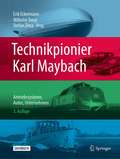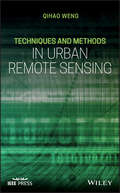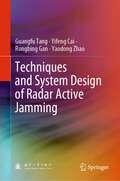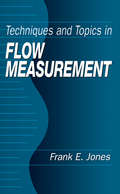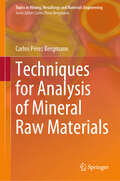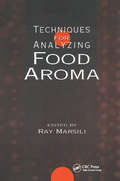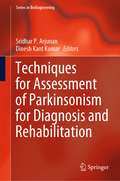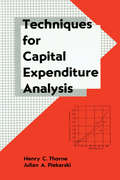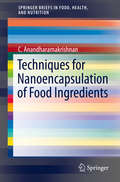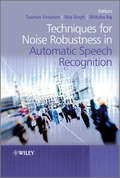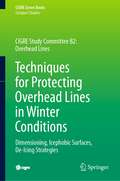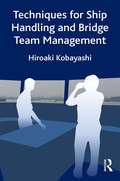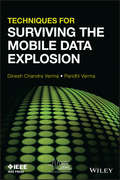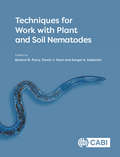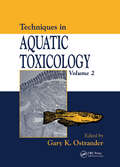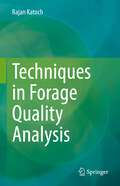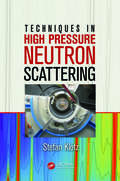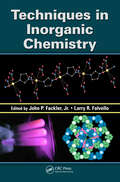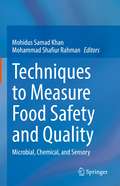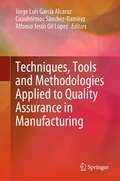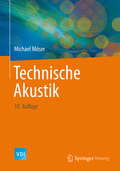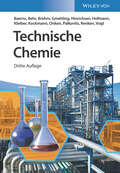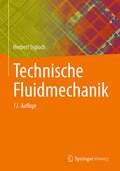- Table View
- List View
Technikpionier Karl Maybach: Antriebssysteme, Autos, Unternehmen
by Hartmut Seeger Alfred Gottwaldt Erik EckermannViele Bücher dokumentieren die glanzvolle Zeit der Zeppeline. Eingebettet in die Weltkriegswirren der ersten Hälfte des 20. Jahrhundert, symbolisieren die großen Zeppeline noch heute technologischen Fortschritt und die Hoffnung auf eine besser vernetzte Welt. Weit weniger ist hingegen über die Männer hinter dem Zeppelinbau, die Baugeschichte und die Auswirkungen auf die heutige Mobilität bekannt. Wilhelm Treue und Stefan Zima haben das Wirken von Wilhelm und Karl Maybach unter diesen Aspekten zusammengestellt. Mit der aktuellen Auflage hat Erik Eckermann den Einfluss auf den Motorenbau zwischen den 60er Jahren bis heute ergänzt und mit einem besonderen Blick auf den Automobilbau erweitert.
Techniques and Methods in Urban Remote Sensing
by Qihao WengAn authoritative guide to the essential techniques and most recent advances in urban remote sensing Techniques and Methods in Urban Remote Sensing offers a comprehensive guide to the recent theories, methods, techniques, and applications in urban remote sensing. Written by a noted expert on the subject, this book explores the requirements for mapping impervious surfaces and examines the issue of scale. The book covers a range of topics and includes illustrative examples of commonly used methods for estimating and mapping urban impervious surfaces, explains how to determine urban thermal landscape and surface energy balance, and offers information on impacts of urbanization on land surface temperature, water quality, and environmental health. Techniques and Methods in Urban Remote Sensing brings together in one volume the latest opportunities for combining ever-increasing computational power, more plentiful and capable data, and more advanced algorithms. This allows the technologies of remote sensing and GIS to become mature and to gain wider and better applications in environments, ecosystems, resources, geosciences, geography and urban studies. This important book: Contains a comprehensive resource to the latest developments in urban remote sensing Explains urban heat islands modeling and analysis Includes information on estimating urban surface energy fluxes Offers a guide to generating data on land surface temperature Written for professionals and students of environmental, ecological, civic and urban studies, Techniques and Methods in Urban Remote Sensing meets the demand for an updated resource that addresses the recent advances urban remote sensing.
Techniques and System Design of Radar Active Jamming
by Guangfu Tang Yifeng Cai Rongbing Gan Yaodong ZhaoThis book serves as a handbook for radar active jamming system designers, in which design principles and methods are introduced in detail. The book starts from the basic concept and then discusses requirements analysis, type selection, key indicators description, and design methods of radar active jamming system and each subsystem step by step. The content is expressed in an intelligible way, and hence, it is easy to follow even for beginners in this area. Since the authors of this book are all experts and have designed plenty of real systems, their book certainly helps new engineers deal with different kinds of problems encountered while designing a radar active jamming system.
Techniques and Topics in Flow Measurement
by Frank E. JonesTechniques and Topics in Flow Measurement covers the applications and techniques of flow measurement. This definitive book provides guidelines for choosing appropriate techniques and assuring valid measurements as well as describes methods for treatment of calibration data in fluid flow under various conditions. The book also covers three systems of units: the SI system, the English Absolute Dimensional system, and the English Engineering system. Commonly used - and often misused - variables such as force, weight, and pressure are defined, and the relationships between the systems for these common variables are summarized.One of the many unique features of Techniques and Topics in Flow Measurement is the number of ready-to-use tables included throughout the text. Tables are provided for such commonly encountered variables as the saturation vapor pressure of water; the composition of dry air; the compressibility factor for air; air-free and air-saturated water density; viscosity of dry air, nitrogen, and other gases; and specific heat/specific volume ratios for dry air, water vapor, and moist air. Another unique feature of this book is the number of highly relevant examples. The author includes examples/exercises that demonstrate applications for density calculations; water vapor mixing ratio determination; gas viscosity interpolation; NIST guideline applications; buoyancy corrections; and more.
Techniques for Analysis of Mineral Raw Materials (Topics in Mining, Metallurgy and Materials Engineering)
by Carlos Pérez BergmannThis book presents a comprehensive exploration of fundamental concepts crucial for assessing the industrial viability of raw materials. Each chapter delves into a phenomenological understanding of various techniques, placing practical insights at the forefront while minimizing reliance on complex mathematical formalism. While recognizing the importance of select mathematical formulations to underpin the underlying physical principles, the primary emphasis remains on accessibility and real-world applicability. Readers will gain a solid understanding of pivotal concepts, equipping them with the proficiency to articulate the symbiotic relationship between analytical techniques and the acquisition of commercially significant insights.
Techniques for Analyzing Food Aroma: Food Aroma (Food Science And Technology Ser. #79)
by Ray MarsiliCovers important methods and recent developments in food-aroma analysis. The text discusses the problem-solving capabilities of analytical methods for food flavours and aromas, showing how to select appropriate techniques for resolving the problems of major food trends. It includes a treatment of off-flavour and malodor analyses and new polymer sensor array instruments.
Techniques for Assessment of Parkinsonism for Diagnosis and Rehabilitation (Series in BioEngineering)
by Sridhar P. Arjunan Dinesh Kant KumarThis book describes the range of technologies that have been developed for diagnosing and assessing Parkinson’s disease patients. Also presenting the latest studies providing insights into the changes to the neural system in Parkinson’s disease, it is a valuable resource for neurologists, general practitioners and nurses. Further, the book highlights areas that require more research, and as such will appeal to researchers, biomedical engineers and clinicians.
Techniques for Capital Expenditure Analysis (Cost Engineering)
by Henry C. Thorne Julian A. PiekatskiThis work examines the most important techniques for analyzing the profitability of capital investments. It discusses time value mechanics and financial concepts, including discounted cash flow, return on investment, incremental analysis, cash flow tables, income taxes, depreciation, cost of capital and risk analysis. It provides a broad introduction to project evaluation and data needs.;This book is intended for: cost, project, design, mechanical, chemical, industrial,electronic,electrical and construction engineers; project and budget managers; cost estimators and controllers; planners and schedulers; and upper-level undergraduate and graduate students in these disciplines.
Techniques for Nanoencapsulation of Food Ingredients
by C. AnandharamakrishnanNanoencapsulation has the potential to improve human health through its capacity to both protect bioactive compounds and release them at a specific time and location into various substances, including food. Numerous nanoencapsulation technologies have emerged in recent years, each with its own advantages and disadvantages. The goal of this Brief is to discuss the various nanoencapsulation technologies, such as emulsification, coacervation, inclusion encapsulation, anti-solvent precipitation, nanoprecipitation, freeze drying, and spray drying, including their limitations. Recent safety and regulatory issues concerning the various nanoencapsulation technologies will also be covered.
Techniques for Noise Robustness in Automatic Speech Recognition
by Tuomas Virtanen Rita Singh Bhiksha RajAutomatic speech recognition (ASR) systems are finding increasing use in everyday life. Many of the commonplace environments where the systems are used are noisy, for example users calling up a voice search system from a busy cafeteria or a street. This can result in degraded speech recordings and adversely affect the performance of speech recognition systems. As the use of ASR systems increases, knowledge of the state-of-the-art in techniques to deal with such problems becomes critical to system and application engineers and researchers who work with or on ASR technologies. This book presents a comprehensive survey of the state-of-the-art in techniques used to improve the robustness of speech recognition systems to these degrading external influences.Key features:Reviews all the main noise robust ASR approaches, including signal separation, voice activity detection, robust feature extraction, model compensation and adaptation, missing data techniques and recognition of reverberant speech.Acts as a timely exposition of the topic in light of more widespread use in the future of ASR technology in challenging environments.Addresses robustness issues and signal degradation which are both key requirements for practitioners of ASR.Includes contributions from top ASR researchers from leading research units in the field
Techniques for Protecting Overhead Lines in Winter Conditions: Dimensioning, Icephobic Surfaces, De-Icing Strategies (CIGRE Green Books)
by Masoud Farzaneh William A. ChisholmThis book offers a comprehensive review of the various options for improving the performance of overhead power lines in winter conditions, taking into account both mechanical and electrical aspects. Experience within the CIGRE community reveals many strategies to protect overhead power lines from damage caused by heavy build-up of ice and snow or electrical issues such as insulator icing flashovers. The initial approach is to consider the predicted ice loads from the available databases. This is supplemented with some fundamental aspects of icing physics that affect accretion rate as well as factors in ice shedding on traditional (metal, ceramic) and novel treated surfaces. These ice physics concepts structure the ways to categorize and evaluate methods to reduce or prevent icing on conductors and ground wires or to prevent flashover of insulators. Many utilities in cold climate regions have developed and used methods and strategies to reduce ice loads using anti-icing (AI) and / or de-icing (DI) methods. In general, AI methods are used before or early during ice build-up, while DI methods are activated during and sometimes after ice build-up. The book describes and discusses some historical, operational, or potential AI / DI systems in the ice physics context. This supports a comprehensive review of AI coatings including concepts, relevant material properties, application methods, and finally test methods for characterizing the long-term performance.
Techniques for Ship Handling and Bridge Team Management
by Hiroaki KobayashiHiroaki Kobayashi has trained 1500 mariners in ship handling over twenty years and he has systematized the methods of safe navigation into nine elemental techniques. Taking a rigorous and scientific look at good practice and attitudes, good seamanship can be viewed as a series of concrete technical functions, which can be in terms of competencies. By giving proper attention to human factors the conditions for maintaining system safety can be defined, and the interaction of human competencies and environmental conditions and their effects on system safety can be recognised. System safety in turn depends on good bridge team management, with particular emphasis on communication, cooperation and leadership – communication for the exchange of information, cooperation to smooth team activities, and leadership to ensure that each member of the team performs successfully.
Techniques for Surviving Mobile Data Explosion
by Dinesh C. Verma Paridhi VermaDiscusses the challenges of bandwidth scarcity due to mobile data explosion and their solutions The rapidly growing popularity of Smartphones and other mobile devices has resulted in an exponential growth of mobile data. There is insufficient radio spectrum to cope with this growing data demand, and upgrading existing networks to meet the demands of mobile data explosion is expensive. Techniques for Surviving the Mobile Data Explosion is about the different approaches that can be used to address the challenges of limited bandwidth. It examines these challenges from the perspective of the mobile network operators, mobile applications developers, and enterprises that deploy mobile applications for their employees. The book provides: Comprehensive yet easy-to-understand information that is free of technical jargon, complex mathematical notation, and multiple acronyms Easy-to-understand figures as well as a comprehensive set of references A cross-disciplinary approach spanning the areas of cellular networks, IP networks, and mobile applications Techniques for Surviving the Mobile Data Explosion is ideal for wireless application developers and mobile network operators.
Techniques for Work with Plant and Soil Nematodes
by Roland N. Perry Sergei A. Subbotin David J. HuntPlant-parasitic and free-living nematodes are increasingly important in relation to food security, quarantine measures, ecology (including pollution studies), and research on host-parasite interactions. Being mostly microscopic, nematodes are challenging organisms for research. Techniques for Work with Plant and Soil Nematodes introduces the basic techniques for laboratory and field work with plant-parasitic and free-living soil-dwelling nematodes. Written by an international team of experts, this book is extensively illustrated, and addresses both fundamental traditional techniques and new methodologies. The book covers areas that have become more widespread over recent years, such as techniques used in diagnostic laboratories, including computerized methods to count and identify nematodes. Information on physiological assays, electron microscopy techniques and basic information on current molecular methodologies and their various applications is also included. This book is an essential resource for students of nematology and parasitology, academic researchers, diagnostic laboratories, and quarantine and advisory service personnel. It provides a much-needed methodology standard for anyone involved in work on plant and soil nematodes.
Techniques in Aquatic Toxicology, Volume 2
by Gary K. OstranderFollowing up on his popular Techniques in Aquatic Toxicology with a second volume, now nine years later, Dr. Ostrander has once again called on the top aquatic toxicologists from across the world to present 39 chapters of unique collection and testing procedures. Updating five techniques from the first volume, the authors have gone on to add over two dozen new techniques. Every chapter covers a specific procedure that can easily be reproduced by any competent technician with basic knowledge. Each of the chapter authors provides and interprets typical and anomalous results, false positives, and artifacts. Data is provided either from recently published experiments or from work being published for the first time.
Techniques in Forage Quality Analysis
by Rajan KatochThe book covers different techniques and methodologies involved in the nutritional quality analysis of forages. It also discusses the nutritional quality, anti-nutritional components, factors affecting forage quality, feed processing and conservation. Different techniques and methodologies have been presented in a simplified manner. The book has been divided in separate chapters and each chapter discusses different aspect of forage quality. Further, the book also covers the topics on conservation and processing of forages and management techniques for improving the forage nutritional quality. This book is an essential source of information for research scholars, post-graduate students and scientists working on forage quality estimation and also in livestock and dairy industries.
Techniques in High Pressure Neutron Scattering
by Stefan KlotzDrawing on the author's practical work from the last 20 years, Techniques in High Pressure Neutron Scattering is one of the first books to gather recent methods that allow neutron scattering well beyond 10 GPa. The author shows how neutron scattering has to be adapted to the pressure range and type of measurement.Suitable for both newcomers and exp
Techniques in Inorganic Chemistry
by John P. Fackler Larry R. FalvelloInorganic chemistry continues to generate much current interest due to its array of applications, ranging from materials to biology and medicine. Techniques in Inorganic Chemistry assembles a collection of articles from international experts who describe modern methods used by research students and chemists for studying the properties and structure
Techniques to Measure Food Safety and Quality: Microbial, Chemical, and Sensory
by Mohammad Shafiur Rahman Mohidus Samad KhanThis book addresses the basic understanding of food contaminants and their sources, followed by the techniques to measure food safety and quality. It is divided into four parts: Part A - sources of contaminants in foods, their associated health risks, and integrated management and alternative options to minimize contaminants; Part B - Technological assessment of conventional methods and selected advanced methods for the detection, identification and enumeration of microbial contaminates; Part C - Technological assessment of different chemical measurements techniques; and Part D – Technological assessment of different instrumental techniques to assess sensory properties of foods.Food safety is a growing concern due to the increase in food-borne illnesses caused by food adulteration, excessive use of pesticides, use of chemical preservatives and artificial fruit ripening agents, microbial contaminations, and improper food handling. Chemical contaminants in food could be transferred from environmental or agrochemical sources, personal care products, and other by-products of water disinfects. In addition, microbial food safety can be threatened due to the presence of many pathogens, such as Salmonella, Escherichia coli, Clostridium botulinum, Staphylococcus aureus, and Listeria monocytogenes in foods. Globally, strict regulations are imposed to limit the potential contaminants in foods. Development of accurate, rapid, and inexpensive approaches to test food contamination and adulteration would be highly valued to ensure global food safety. There are existing processes to ensure safety of food products from chemical and microbial contaminants. Apart from the existing measurement technologies, varieties of new techniques are also being emerged and these could be potential to ensure food safety and quality. In addition to chemical and microbial properties, sensory properties such as texture, mouth feel, flavor, and taste, are among the most important attributes of food products to ensure their acceptability by consumers. Two approaches are available to evaluate sensory properties of food products, namely subjective and objective analyses. The responses are perceived by all five senses: smell, taste, sight, touch, and hearing. The approach used in sensory evaluation varies depending on the types of foods and the ultimate goal of the testing. Sensory attributes are the most important quality parameters after ensuring the safety of foods.
Techniques, Tools and Methodologies Applied to Quality Assurance in Manufacturing
by Cuauhtémoc Sánchez-Ramírez Jorge Luis García Alcaraz Alfonso Jesús Gil LópezThis book presents a collection of real cases from industrial practices that production system and quality managers implement to ensure a high quality as well as a low cost in products. This book is divided in sections that are focused on: · The quality and philosophies implemented to production systems; starting from the product design as well as from the supply system. · The principal statistical techniques applied to the quality assurance (statistical quality control, analysis of tests and failure, quality function deployment, accelerated life tests, among others), the process of gathering information, its validation, its reliability process, and techniques for data analysis. · The techniques applied to the integration of human resources in the process of quality assurance, such as managers and operators’ participation, training, and training processes. · Use of information and communications technologies, software, and programs implemented to guarantee the quality of the products in the production systems. ISO standards and policies that are used for quality management and monitoring.
Technische Akustik
by Michael MöserDas Standardwerk der Akustik ist auf die Ingenieursausbildung zugeschnitten. In allen Kapiteln steht die Frage im Mittelpunkt, wie die Lautstärke in den wichtigsten Umgebungen (in Gebäuden und im Freien) verringert werden kann. Begleitend wird das notwendige Grundlagenwissen über die Natur von Schall und Schwingungen vermittelt. Für die Neuauflage wurden schalltechnische Normen aktualisiert, die Themen Wellenausbreitung sowie Schallschutzwände erfahren besondere Aufmerksamkeit. Mit Zusammenfassungen, Übungsaufgaben und Lösungen zu jedem Kapitel.
Technische Chemie
by Norbert Kockmann Albert Renken Arno Behr Jürgen Gmehling Michael Kleiber Manfred Baerns Axel Brehm Kai-Olaf Hinrichsen Hanns Hofmann Ulfert Onken Regina Palkovits Dieter VogtDas grundlegende Lehrbuch der Technischen Chemie mit hohem Praxisbezug in der dritten Auflage: * beschreibt didaktisch äußerst gelungen die Bereiche - chemische Reaktionstechnik, Grundoperationen, Verfahrensentwicklung sowie chemische Prozesse * alle Kapitel wurden komplett überarbeitet und aktualisiert * zahlreiche Fragen als Zusatzmaterial für Studenten online auf Wiley-VCH erhältlich * unterstützt das Lernen durch zahlreiche im Text eingestreute Rechenbeispiele, inklusive Lösung * setzt neben einem grundlegenden chemischen Verständnis und Grundkenntnissen der Physikalischen Chemie und Mathematik kein Spezialwissen voraus *NEU: Neue Technologien und Rohstoffe relevant für moderne industrielle Prozesse Ideal für Studierende der Chemie, des Chemieingenieurwesens und der Verfahrenstechnik in Bachelor- und Masterstudiengängen.
Technische Fluidmechanik
by Herbert SiglochDieses erfolgreiche Lehrbuch vermittelt die Grundlagen der Fluidmechanik und deren praxisbezogene Anwendung, geht jedoch über eine Einführung hinaus. Die strömungstechnischen Phänomene werden beschrieben und mathematisch exakt oder - falls dies nicht möglich - näherungsweise dargestellt. Sie werden durch Messwerte unterstützt und weitgehend physikalisch begründet. Zum besseren Verständnis sind die Erscheinungen der Fluidmechanik ausgehend von der Festkörpermechanik veranschaulicht. Dabei werden Analogien zu anderen Fachgebieten aufgezeigt. Dargestellt sind die Statik und Dynamik sowohl der Flüssigkeiten als auch der Gase und Dämpfe. Bei der Gasdynamik sind Unterschall- und Überschallströmungen einbezogen. Eine Einführung in die moderne numerische Strömungsmechanik - die Computational Fluid Dynamics (CFD) - ergänzt den Stoff. Hinzu kommen 100 Übungsbeispiele mit kompletten Lösungen. Der Anhang enthält technisch wichtige Tabellen sowie Diagramme für Stoffgrößen und Beiwerte der Strömungstechnik.In der 11. Auflage wurden Inhalte überarbeitet und das Werk wurde in ein neues Layout überführt.
Technische Grundlagen Eingebetteter Systeme: Elektronik, Systemtheorie, Komponenten und Analyse
by Karsten Berns Alexander Köpper Bernd SchürmannLernen Sie mit diesem Lehrbuch eingebettete Systeme besser kennenEmbedded Systems (eingebettete Systeme) sind aus dem Alltag nicht mehr wegzudenken. In Smartphones, Fahrzeugen oder Haushaltsgeräten verbinden sie die analoge mit der digitalen Welt. Daraus ergeben sich speziell für Entwickler eingebetteter Systeme viele Anforderungen. Sie müssen nicht nur Kenntnisse aus der Entwicklung von Softwaresystemen mitbringen, sondern gleichzeitig Wissen in Sachen Elektrotechnik oder Systemkomponenten besitzen. Dieses Lehrbuch führt Sie umfassend in das Feld eingebetteter Systeme ein. Die Autoren liefern Ihnen das notwendige methodische sowie systematische Wissen zur Systementwicklung. Zum optimalen Verständnis ist dieses Werk in vier Teile untergliedert:Technische Grundlagen eingebetteter Systeme aus den Gebieten Elektronik, Systemtheorie, Steuerung und Regelung Systemtheoretische Grundlagen und Entwürfe von ReglernÜberblick und Einbindung der Systemkomponenten eingebetteter SystemeModellierung und Analyse von Algorithmen mit Blick auf EchtzeitanforderungenDurch Anwendungsbeispiele und Methoden der Echtzeitplanung können Sie mit diesem Lehrbuch Ihr Wissen im Bereich eingebettete Systeme nachhaltig vertiefen. Inhaltlich für Praktiker und Theoretiker zu empfehlenAufgrund seines thematischen Schwerpunkts profitieren von diesem Werk speziell folgende Leser:a) Studierende und Anwender der Informatik ohne tiefgreifende Vorkenntnisse im Bereich Elektrotechnikb) Ingenieure, Physiker und Mathematiker, die sich für die Grundlagen der Entwicklung eingebetteter Systeme interessierenIn den einführenden Kapiteln des Lehrbuchs definieren die Autoren zunächst die Merkmale eingebetteter Systeme. Sie zeigen Ihnen Anwendungsfelder und erläutern, in welcher Form diese Systeme zum Einsatz kommen – beispielsweise als Cyber-Physikalische Systeme (CPS). Im weiteren Verlauf werden u. a. diese Teilaspekte näher behandelt:Elektrische NetzwerkeElektronische GrundschaltungenSignalverarbeitungsprozesseSensordatenverarbeitungAktuatorikRecheneinheiten für eingebettete SystemeKommunikationEin Grundlagenwerk mit verständlichem KonzeptDurch seinen systematischen Aufbau ermöglicht Ihnen dieses Werk einen schnellen Einstieg in die Materie. Anschauliche Tabellen, Grafiken, Anwendungsbeispiele sowie Modelle unterstützen Sie beim Lernprozess. Wenn Sie sich für eingebettete Systeme interessieren, darf dieses Lehrbuch in Ihrer Sammlung nicht fehlen.
Technische Mechanik
by Wolfgang Weißbach Alfred Böge Gert Böge Walter Schlemmer Wolfgang BögeSeit vielen Jahren ist der Böge das Standardlehrwerk für die Technische Mechanik an den Technikerschulen. Gründe dafür sind die systematische, klare und leicht zugängliche Darstellung des Stoffes in Text und Bild und die durch ausführliche Beispiele, Arbeitspläne und Übungen erleichterte Nacharbeit der im Unterricht behandelten Themen. Deshalb hat das Lehrbuch seit langem auch Eingang gefunden in das Studium an Fachhochschulen und den Höheren Technischen Lehranstalten in Österreich. Der Autor stimmt dieses Lehrbuch fortwährend auf die sich wandelnden beruflichen Anforderungen an die künftigen Techniker und Ingenieure ab. In der aktuellen Auflage wurde der Impulserhaltungssatz aufgenommen.
